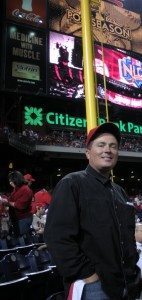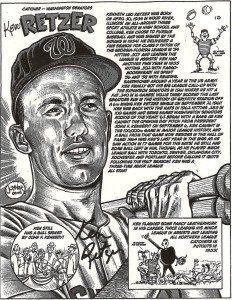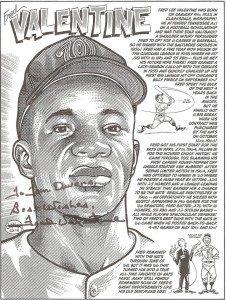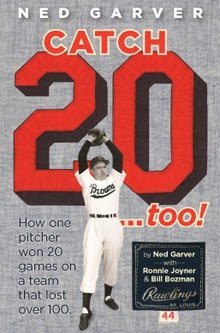Ned Garver remains a winner.
Ronnie Joyner
One Collector’s Craziest TTM Autographs

Ronnie Joyner has shared his insights as a baseball artist this week. Today, he tells of his life as an autograph collector. Don’t believe that former players care what you put in your letters? Joyner learned early that every word matters.
He recalled:
“Aside from the many great letters I received, there were some dubious (and funny) moments, too, that I remember off the top of my head:
– Tommy Byrne yelling at me for mentioning his St. Louis “Cardinal” years. He never played with the Cards. I meant to write St. Louis “Browns”. We became Brownie acquaintances years later.
– Gene Conley getting snippy about autograph collectors and why he was “forced” to charge. His note informed that he had three options:
1. Throw the enclosed card in the trash
2. Return it unsigned
3. Request a signing fee.I never minded the guys that charged, I just didn’t like Conley’s accusatory tone. I always felt my thoughtful, hand-written letters should have separated me from the collectors who were only interested in making a buck off a player’s autograph, but some guys just hated the whole bunch of us no matter what. Nowadays, in my mellow old age, I would have just laughed it off. Being an angry young man at the time, however, I had to fire off a rebuttal while rejecting his offer to sign for, what was certainly, a small amount of money. It was the principle!
I sent my card back and told him he could do “option 1.” I told him that it was my contention that any decent guy wouldn’t have “option 1” as an option. How rotten is it to throw a kid’s card in the trash? Anyway, the problem was that I really wanted a signed 1956 Topps Conley because I was trying to accumulate as many sigs from the’56 set, one of my favorites, as possible. So it doesn’t pay to have principles when you want something.
So principled was I that I re-wrote Conley a letter under the pseudonym “Spanky Bozman” — and enclosed the autograph fee. I used my buddy Bill Bozman’s address, but forgot to tell Bill about my scheme. When the signed card arrived at his house, Bill called me and asked who the heck was Spanky Bozman! I had some ‘splainin’ to do.
But to this day, my Gene Conley ’56 “Spanky” card is one of my favorites. I still suspect that Conley knew the whole deal. I did a bio-illustration of him years later to make amends.
– Al Worthington calling into question my Christianity. “All the autographs in the world won’t help you get into heaven”. He enclosed a pile of literature and signed my card. Still, I resented this challenge to my Christianity. I thought I could be a good Christian AND an autograph collector. So, again, in the stupidity of my youth, instead of laughing it off, I rebutted him in a reply. Nothing overly confrontational, but a rebuttal nonetheless.
Stupid kid. I regret it to this day and I may reach out to him again. Funny thing — when I was helping Don Gutteridge write his memoirs back in 2008, we discussed an interesting story about Worthington. Don was a coach with the White Sox all through the 1960s, and Worthington was a pitcher there for a handful of games in 1960. Don, himself as solid a Christian as you’d ever meet, confirmed that the Sox were stealing signs from opposition catchers via a guy with binoculars hiding in the centerfield scoreboard. Worthington, apparently already solidly entrenched in his Christianity, did not like the dishonesty of the covert operations. He complained to management, refused to go along, and was promptly released. As I said, Don was a good Christian man, but he referred to Worthington as a “holy roller” type, which tells me that Worthington’s approach to sharing his Christianity has apparently rubbed everybody wrong forever. Still, I should contact him about the whole thing. I’m sure it would make for an interesting bio-illustration or straight-up article.
– Russ “The Mad Monk” Meyer getting confused. I wrote a long, thoughtful letter to Nats great Buddy Meyer. Problem was, Buddy was dead. I got my lines crossed and thought Buddy was alive and well because I was attributing the “alive-and-well” Russ Meyer’s address to the “dead-and-gone” Buddy Meyer.
Anyway, Russ writes back saying, “I don’t know who Buddy Meyer is,but I used to be a pro ballplayer.” Then he proceeded to write out all ofhis career achievements as if I had no clue who he was. Pretty dang funny. Iwrote him back and filled him in on the mistake. I did a bio-illustration of Russ years later because he was just too colorful not to draw, but, unfortunately, he died a few years before I got around to it.
Gotta love the hobby!”
(Ronnie is pictured at the 2009 NLCS game in Philadelphia. Photograph courtesy Ronnie Joyner)
Joyner Fields Fan Mail FROM Players

Baseball artist Ronnie Joyner has savored the Triple Crown of success. Some artists must settle for getting published or paid. Joyner’s gone the extra base of sorts, reaping praise from those he depicts.
When the accolades come, none are taken lightly. Even after retirement, tight-lipped players remain men of deeds first, words second.
Joyner shared the experience of having baseball history as his teacher.
Q: How do you describe your work?
I don’t know what this type of art was technically called in its heyday (1920s-60s), but for lack of a better term I just started calling my version of this genre “bio-illustration”. I’d always admired the old newspaper legends of this genre — Thomas “Pap” Paprocki, Willard Mullin, Lou Darvas, Jim Berryman, Phil Berube, etc., etc., but I never thought I would have the venue (albeit it a smalltime venue) to bring it back on the scene. But POP FLIES gave me the opportunity, so I began creating a Brownie bio-illustration for each quarterly issue. Soon I was creating bio-illustrations of Senators, Braves (Boston) and Athletics (Philadelphia) players for their fans’ similar publications. Eventually I began creating a weekly bio-illustration for SPORTS COLLECTORS DIGEST (SCD. This was great because it allowed me to draw players from all teams and all eras. While I have illustrated a good number of mainstream and Hall-of-Fame players, I have always taken particular interest in illustration of lesser know guys.
No disrespect intended to the big-name guys, but I feel there are plenty of other avenues to learn about them, so I like to carry the torch for the little guys. Now I have drawn close to 200 guys, and my hope is that I will someday publish them all in a book.
Q: I received photocopies of your bio-illustrations of Jim Greengrass, Fred Valentine, and Ken Retzer after corresponding with them through the mail. How do you feel about that?
A: That really makes me happy. I am truly honored that they choose to utilize my bio-illustrations to tell the story of their careers when they correspond with their fans. I will occasionally meet a player who I’ve previously illustrated — a guy who I’d not previously met. Sometimes when they put two-and-two together and recognize my name they’ll tell me that they received copies of my bio-illustrations in the mail from fans who clipped them out of SCD. That always makes my day. That reason alone often makes me prefer illustrating living guys, but every now and them I’ll dip back into the lives of deceased players for my subjects.
Q: Are you writing the great bios, too?
A: Yep, I write ’em and draw ’em. I’ve always enjoyed researching and writing, so this gives me an outlet for that passion. I occasionally write straight-forward article-type stuff, so my bio-illustration text allows me to ham it up a bit in the style of the genre — you know, lots of silly jargon like “swiped 20 bags,” “clubbed 20 round-trippers,” “fence-buster,” “port-sider,” etc., etc. One thing you may have noticed is that I always end EVERY sentence, even the most mundane of statements, with an exclamation point (unless the piece is particularly serious like that of Willard Hershberger, for example). That’s something I picked up from my comic book
reading days. I thought every one would get the joke, but I have actually had complaints about it from the occasional SCD reader.
Q: Have you corresponded with the retirees BEFORE a work is created? It seems most retired players will answer an interesting question if asked politely.
A: I have, in fact, talked with players before doing a drawing, but usually only if someone has asked me to illustrate someone obscure for whom it is difficult to find reference material. A couple of recent examples are Red Borom and Ducky Detweiler. Most of the time I just go at it on my own. I used to always send the players a batch of copies of my finished drawing AFTER completion, but I’ve done less and less of that these days due to being overly busy.
I never thought I’d see the day where I would forgo the possibility of a cool interaction with a player because I am too busy, but that’s sadly the case. When I do reach out to players by sending them copies, their reactions are, amazingly, mixed. There are guys who are very gracious and friendly, but there are also guys who seem to care less. And it’s not just the guys you’d think, either. Some times it may be a HOFer who is blown away, yet the unknown guy seems unimpressed. But usually it’s the other way around. Accolades from guys like Greengrass and Retzer, however, make it worth the time and effort to try and communicate to every guy.
Q: What kind of response do you get AFTER they see your work? This is like
the back of a great old Topps card. Even greater!
I don’t mean to dampen your enthusiasm too much, but it’s hard to impress most players. Even the most short-time player was usually great in all his seasons leading up to his major league experience. That means they all have stacks of scrapbooks (I’ve seen ’em!) loaded with clippings about their heroic baseball exploits. Many have already been depicted in illustrations like mine by the sports artists of their time. Or they’ve been on classic baseball cards. And many of the more well-known players I’ve illustrated have already been the subject of paintings/illustrations by well-known artists versus a no-name (it is what it is) like me. For those reasons, many players tend not to be bowled over
by yet another tribute to them.
That said, there are definitely enough guys out there who love what I do for them, and that makes it fun. 1945 A.L. MVP Eddie Mayo paid me the ultimate compliment by telling me my bio-illustrations were better than any baseball card could ever be because it captures the fun of a card, yet it’s much more informative. A quick look at a list of my drawings reminds me of some guys who have been very enthusiastic about my bio-illustrations of them: Rugger Ardizoia, Joe Astroth, Eddie Basinski, Bobby Bragan, Al Brancato, Joe Cunningham, Clint Dreisewerd’s family, Mike Epstein, Boo Ferriss, Ned Garver, Chuck Goggin, Eli Grba, Don Gutteridge, Spook Jacobs, Johnny James, George Kell, Al LaMacchia, Frank Mancuso, Hal Manders, Walt Masterson, Lee Maye, Brian McCall, Ralph McLeod, Dick Means’ family, Ed Mickelson, Al Naples, Bob Neighbors’ family, Herb Plews, Jackie Robinson’s wife Rachel, Bob Savage, George Shuba, Billy Southworth’s (dad and son) family, Virgil Trucks, Lon Warneke’s daughter, Bill Werber and Ken Wood.”
Remember how Joyner noted that he was a baseball autograph collector first? Tomorrow, he’ll divulge a few of his TTM misadventures with names you’ll know!
Meet artist (and collector!) Ronnie Joyner

Baseball artist Ronnie Joyner must be a time traveler.
Today’s baseball fans don’t have a Willard Mullin or Bill Gallo to capture their favorite diamond heroes in newspaper art. Photos are everywhere. The pen-and-ink artists disappeared as photographers multiplied.
Don’t tell Ronnie Joyner. Thanks to him, the medium is roaring back in places like Sports Collectors Digest. You might catch him depicting a current player in a rare diversion. Usually, he’s honoring the men of baseball’s yesteryear, adding an insightful biography to every artistic tribute.
His 2010 illustration of a retiree could have graced a sports section 50 years ago. (Why couldn’t Topps ever fit this much handsome info on the back of a card?!?) Best of all, Joyner is rewarding faithful fans of overlooked organizations like the Philadelphia Athletics or the Washington Senators.
Joyner’s arrival in baseball retro art started by collecting autographs through the mail! Here’s how he tells it:
“My whole foray into baseball-related art/writing projects came about as a by-product of writing to players for their autographs. I became good friends with a guy (Bill Bozman) around 1985. We worked together at an ad agency, and we soon found that we were both fanatics for baseball. He played ball for Maryland’s Northwestern High School (alma mater of the great Len Bias), while I had played at Oxon Hill High (alma mater of no one really great!).
He was three years older than me, so we’d never played against each other, but we still had a lot of stories we could share. One day my girlfriend (now wife) and I went over to Bill and his wife’s house for dinner, and I decided to take my old shoebox full of baseball cards for him to look at. I was proud of my old collection of cards, but my eyes were soon popping when Bill showed me HIS collection. Nothing but SIGNED cards, photos, postcards, etc.
It turned out that Bill and his brother has spent a great deal of their free time as kids writing to ballplayers and requesting their autographs. The bulk of what they collected were contemporary players of the day (late-60s/early-70s), but Bill said he once saw an ad somewhere that offered a list of baseball addresses for a dollar. He bought it and was able to acquire a lot of nice signatures of old players who would be gone from this Earth by the time 1980 rolled around.
Well, seeing Bill’s signed items made me feel mighty silly for not having thought of writing in my younger days, but I figured better late than never.
We found a copy of Smalling’s address list [of home addresses for current and former players](I think it was #3 or #4), and we were off and running, writing with a fury. I concentrated on the old-timers first, sending them reprints of their old Goudey cards. Eventually, I expanded my writing to guys through the 1960s, but I wasn’t really interested in writing contemporary players of the time. I always took great pains to hand-write a full-page letter, chock full of info specific to the player — and I was always ultra-polite. While I was into the aspect of quantity, which you discuss, I also found myself enjoying the “extras” that came back in many of my envelopes — a photo, a postcard, a business card, a clipping, or, best of all, a note.
Around 1993 I sent a “reprint” Play Ball card to a little-known Browns catcher named Frank Mancuso. In his return letter he asked me if I knew where he could get a bulk-lot of copies of the card I’d sent him so he could send them to his fans who wrote him requesting a card. I told him I didn’t think it was possible, but I told him I was an artist and I’d be glad to make him a card — even better than the Play Ball card. Youthful cockiness.
Anyway, I did it and Frank and I became good friends. He hooked me up with the St. Louis Browns Historical Society for whom I began to produce their quarterly magazine and reunion programs. I also created a fully illustrated card set commemorating the 1944 AL Champion Brownies, a club Frank was on. I also eventually did another card set of the 1953 Browns. Both sets are still sold by Larry Fritch up in Wisconsin.
Other baseball opportunities shot off from my relationship with Frank and the Browns — work with the Boston Braves Historical Society, the Philadelphia Athletics Historical Society, the Washington Senators Historical Society, and book projects with players like Don Gutteridge, Virgil Trucks, Ned Garver, Frank Thomas (Pirates), Bob Dillinger, and Gus Zernial. All this from simply writing players. It’s been great.”
Tomorrow, discover more about Joyner’s baseball art techniques, along with news of the players that have embraced his creations.

